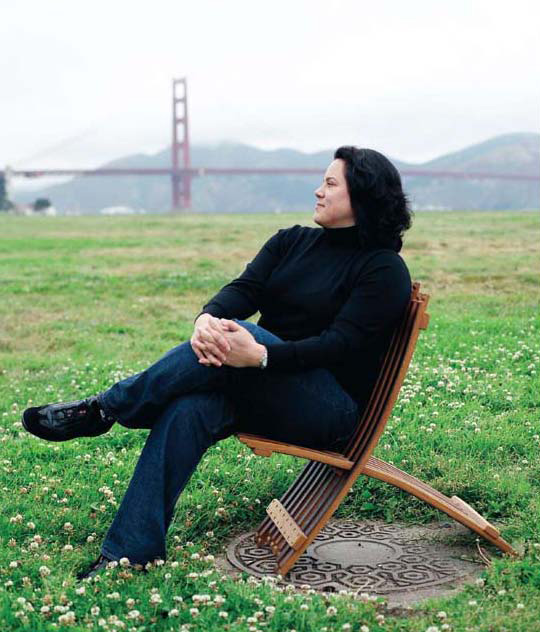Move Over, Lara Croft: Not All the Women in Video Games Are Digital

Photo by Jude Mooney Photography
When you think of video games, you probably picture a geeky teenage boy camped out in a living room, chomping on potato chips while piling up points racing from one virtual level to the next. (You don’t imagine girls at a slumber party playing Super Mario Brothers, right?) The $42 billion-a-year worldwide video-game industry still reflects this stereotype, but career women in the field—such as Patricia Su Yin Kallusch ’93—may help change all that.
If you think video games are just kid stuff, think again. They’re the fastest-growing segment of the entertainment industry, and computer- and video-game sales are expected to surpass movie box-office revenues by the end of 2008. Grand Theft Auto IV, released in May, set a record for day-one sales in any entertainment sector.
Kallusch, who played video games casually while growing up, wondered how she would use her MHC studio art degree. Internships with a New York City sculptor and in the design department of DC Comics made her realize the broad possibilities of commercial art.
The video-game industry began to boom while Kallusch was in her mid-twenties. “Three-dimensional animation was really taking off,” she recalls, and 3-D artists originally interested in film careers took notice of the skyrocketing video-game sector. Armed with an MFA in computer animation, Kallusch built a career as an animator and video-game environment artist, then moved up the managerial ranks as though mastering levels in one of the games.
While an animator, she worked primarily as an environmental modeler for Electronic Arts, making the physical worlds video-game characters navigate. For example, she modeled the golf courses for the PlayStation 2 Tiger Woods PGA Tour game. After five years at Electronic Arts, the globe’s largest producer and publisher of video games, Kallusch was recruited by LucasArts to work on Star Wars: The Force Unleashed game, which came out in September.
 At LucasArts she directed a team of thirty artists in varied disciplines. One role was to produce character art and animation. This included the production of visualization, creation, and animation of Darth Vader, his secret apprentice (pictured at left), and other characters (including Maris Brood, below, left). She also produced cinematics (brief movies) for the game and ran the project’s art outsourcing with teams at Industrial Light and Magic and Lucasfilm Animation in Singapore.
At LucasArts she directed a team of thirty artists in varied disciplines. One role was to produce character art and animation. This included the production of visualization, creation, and animation of Darth Vader, his secret apprentice (pictured at left), and other characters (including Maris Brood, below, left). She also produced cinematics (brief movies) for the game and ran the project’s art outsourcing with teams at Industrial Light and Magic and Lucasfilm Animation in Singapore.
Working with colleagues in design, marketing, and engineering, she managed art “assets” for the game. This could mean anything from driving the creation of marketing pieces to overseeing development of concept art used to inspire the designers and artists working on the game. “I was in charge of the art piece of the pie,” Kallusch summarizes. “As a producer and development director, coordination is key. I’ve been on afew projects [with] almost 200 people working together to create thegame. Defining and driving processes for art-asset creation isimportant because art is a key element of what enhances the experienceand makes players feel like they’re in the game.”
That sense of immersion reflects video games’ role as a new form of storytelling. Early games such as Donkey Kong and Pac-Man were all about scoring points. But some of today’s video games “involve more storyline, [so] the player can experience more emotion through the story, similar to how a person relates to a character in a film or a book,” Kallusch explains. “Different genres of games provide for different game-play experiences.” And recent game narratives emerge on the screen as fingers furiously tap controllers, with the story evolving differently for each player. “You’re actually creating an experience,” Kallusch says of games like Star Wars: The Force Unleashed and Grand Theft Auto. “Video games are a growing part of the future of the entertainment industry, and they are more and more about character,story, and emotions.”
 Where Are the Women?
Where Are the Women?
This spring Kallusch returned to work for Electronic Arts, where she is doing the same tasks as at LucasArts, only on a much higher level. Currently she is in charge of a team of seventeen artists, only one of whom is a woman. “Being able to go toe-to-toe with other artists, regardless of gender,” was part of the industry’s appeal to Kallusch.
There are still many more “Lara Crofts”—female video-game characters— than actual women creating the games; Kallusch is among the few women managers. “Women probably think it is a bunch of nerdy guys … [but the industry] lends itself to so many jobs women may be interested in,” she notes, as if eager for female colleagues.
Would the presence of more women change the industry? Kallusch notes that customer demand drives video-game content, with men ages eighteen to thirty as the prime targets of video-game marketing. If that audience wants a game where women are busty and violent crime runs rampant, games will reflect that. Kallusch believes that the nature of the product will change only when women find a place in the industry and get more into gaming as entertainment.
Things are already starting to shift. According to the Entertainment Software Association, 38 percent of gamers are female, and they spend an average of 7.4 hours each week playing video games. Kallusch mentions that while the chances are slim of finding a woman in her thirties who is really into games like Grand Theft Auto, the social nature of other games may begin to build a new female consumer base. Socially oriented role-playing games such as The Sims series (which lets players simulate day-to-day activities such as eating, sleeping, and working, and control characters’ destinies) are popular with women. According to eMarketer research, females also prefer “casual games,” such as computer versions of board, card, and word games, rather than the battle games favored by males.
Although the video-game industry is still male-centered and male-dominated, Kallusch says anything can change if women infiltrate the animation floors and other parts of the business. She notes, “I didn’t see any ‘no girls allowed’ signs when I came in here.”
—By Caitlin Healey ’09
Caitlin Healey ’09 is an English major who is considering a future as a gamer. This article appeared in the fall 2008 issue of the Alumnae Quarterly.
Learn More
This Web-exclusive content is offered in connection with the fall 2008 Mount Holyoke Alumnae Quarterly magazine article “Move Over, Lara Croft: Not All the Women in Video Games Are Digital,” by Caitlin Healey ’09.
Women and Videogames
• According to the Entertainment Software Association, 38 pe
rcent of gamers are female, and they spend an average of 7.4 hours per week playing video games.
• GIRL (Gamers in Real Life) is a scholarship program created by Sony Online Entertainment to attract more young women to careers in game development.
• Twelve percent of those employed in the videogame industry are female, according to the International Game Developers Association. (Women comprised 46 percent of the total U.S. workforce in 2007.)
• Women in Games International (WIGI) — This nonprofit organization was founded to include and advance the position of women in the game industry.
• A 2007 survey by eMarketer found that a slightly higher percentage of women than men use the Internet in general, but that “females, especially adult women, are more likely to use the Internet to get things done, rather than to have fun.”
• In a 2006 Nielsen Entertainment study, “women make up nearly two-thirds of all online gamers, [but] men still outnumber women in the overall video game universe by more than two to one.”
• Preview the New Star Wars Game
Check out the Star Wars: The Force Unleashed videogame at its official LucasArts Web site.
Nancy Philippine, a former manager of Pat’s at Electronic Arts (world’s largest producer and publisher of video games), talks about Pat Kallusch and the video game industry
How to Succeed in the Industry: I had the chance to follow closely Pat’s career at Electronic Arts (EA) from the time she started as an intern in the art department to now as an art development director. Pat’s skills and her desire to deliver the highest quality of work were appreciated from day one and are what allowed her to progress the way she did.
The role of an artist in the video game industry requires a different mindset than in other industries. You need the talent, but you also need to understand the technical restrictions. It has to be beautiful, but it also needs to fit in as little memory as can be. Using a 3-D application like Maya or Softimage can be a challenge for 2-D artists, but making these models migrate to the video game consoles is the next step above in complexity.
Pat belonged to this elite of artists who could work closely with engineers and translate the technical specifications to top-notch models and splendid textures, which complied with the requirements. (Think golf courses: lots of grass and trees but it also needs to look real and transport the player to golf courses he has seen on TV. Not easy!)
You also have to be well-organized. All pieces of your work have to be stored in specific locations and follow naming conventions. Why? First, somebody else might be using the same piece. Then, all game assets are recreated from bottom-up for each version. Complex scripts go fetch everything and work their magic to convert, combine, and compress all the data to their final format. If the script chokes because it does not find a texture or any other piece, you might be impacting the work of 100 people or more for the next day. You don’t want to do this too often.
Pat always had a lot of ownership for her work. She would be very meticulous and understand her place in the big picture. When you have 20 to 50 artists working on the content of one game, you don’t want to have to run behind each of them to make sure things are done right. Pat understood that and progressively started to monitor that process and supervise more junior artists and train them to follow the processes and pay attention to details. Not always easy for “right brains.”
As she got to work closely with the “left-brain” engineers, Pat got a passion for figuring out the pipelines with them. Optimizing the work is key on games. She really helped a lot on that matter.
Things evolve quickly in the industry. You have to be able to adapt and accept the changes. One aspect that was really tough for the art team was the fact that the more content you needed, the more artists were needed to meet the deadlines and the higher the cost went. To work around that, outsourcing became very popular. It had a lot of positives but it also meant a change of role for the internal team: managing the external team and fixing the issues that might have occurred from distant communication. Not easy to pilot this remotely. Another key role that Pat covered very successfully!
From there, the evolution is obvious. Pat has all the experience and profile to get to the next step of managing a team of artists, being responsible for their schedule, the processes they will follow, and the communication with the production team and the engineering team.
All of this understates the hard work and the long hours spent to meet tight deadlines. The industry is season-driven. You cannot miss your release date without major financial consequences. Crunch time is a reality but it is balanced with more flexibility in your day-to-day schedule. Core hours are a necessity to the collaborative work but as long as you deliver your part, you gain trust and freedom. It’s as tough for men or women; we are all on the same boat.
On being female in a male-dominated industry: Mainly it depends on the game you are working on. I was lucky enough to work on quite a variety, from shooters to racing games to golf games to the Sims. The Sims team included a lot of women in production and design—very unusual! All the other games were more targeting core players and had mostly a male staff, except for the art team. It’s starting to change now that girls are getting to play more games as well.
The goals are well-set and if you are self-driven, there is no reason for you not to succeed.
One of the important factors to growth is to find some good mentors. I was lucky to have many along the way who helped me through what felt like a natural progression. I’m sure Pat can relate to this as well.
On changes in the video game industry: It is challenging, evolving constantly, and most of all it regroups a fantastic set of people. Every time I thought I could finally rest, a new platform would come, changing the rules, asking us to experiment with new approaches not only on the technology but also on the project management.
The early teams (15 years ago) were made up of a couple of engineers. Then you had 5-10 engineers and 1 or 2 artists. Then you started seeing 15-20 engineers and 5 level designers and 15-20 artists and now it’s more 30-35 engineers and 10 level designers and 40-50 artists. It’s quite a reversed situation. And from day one, getting the right brain to meet the left brain has fascinated me.
November 28, 2008










Leave a Reply